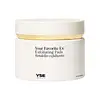What's inside
What's inside
 Key Ingredients
Key Ingredients

 Benefits
Benefits

 Concerns
Concerns

 Ingredients Side-by-side
Ingredients Side-by-side

Water
Skin ConditioningGlycolic Acid
BufferingGluconolactone
Skin ConditioningPropanediol
SolventPentylene Glycol
Skin ConditioningEthoxydiglycol
HumectantSodium Hydroxide
BufferingEctoin
Skin ConditioningVitis Vinifera Juice Extract
AntioxidantSodium Polyglutamate
HumectantPassiflora Edulis Fruit Extract
Skin ConditioningMangifera Indica Fruit Extract
Skin ConditioningPrunus Persica Fruit Extract
AbrasiveCucumis Sativus Fruit Extract
EmollientCitrus Paradisi Peel Extract
PerfumingCucumis Melo Fruit Extract
Skin ConditioningCitrus Limon Peel Extract
EmollientPyrus Malus Fruit Extract
Skin ConditioningCitrus Aurantium Dulcis Peel Extract
Emulsion StabilisingRosa Damascena Flower Extract
MaskingTetrasodium Glutamate Diacetate
Sorbitan Oleate Decylglucoside Crosspolymer
CleansingWater, Glycolic Acid, Gluconolactone, Propanediol, Pentylene Glycol, Ethoxydiglycol, Sodium Hydroxide, Ectoin, Vitis Vinifera Juice Extract, Sodium Polyglutamate, Passiflora Edulis Fruit Extract, Mangifera Indica Fruit Extract, Prunus Persica Fruit Extract, Cucumis Sativus Fruit Extract, Citrus Paradisi Peel Extract, Cucumis Melo Fruit Extract, Citrus Limon Peel Extract, Pyrus Malus Fruit Extract, Citrus Aurantium Dulcis Peel Extract, Rosa Damascena Flower Extract, Tetrasodium Glutamate Diacetate, Sorbitan Oleate Decylglucoside Crosspolymer
Water
Skin ConditioningLactic Acid
BufferingGlycolic Acid
BufferingSalicylic Acid
MaskingNiacinamide
SmoothingHamamelis Virginiana Water
AstringentMaltodextrin
AbsorbentAloe Barbadensis Leaf Juice Powder
Skin ConditioningChamomilla Recutita Flower Extract
MaskingCucumis Sativus Fruit Extract
EmollientGlycyrrhiza Glabra Root Extract
BleachingPanax Quinquefolius Root Extract
AstringentPapain
Skin ConditioningBromelain
Skin ConditioningCitric Acid
BufferingAmylopectin
Dextrin
AbsorbentEthylhexylglycerin
Skin ConditioningSodium Hydroxide
BufferingPotassium Sorbate
PreservativePhenoxyethanol
PreservativePropanediol
SolventPolydextrose
HumectantWater, Lactic Acid, Glycolic Acid, Salicylic Acid, Niacinamide, Hamamelis Virginiana Water, Maltodextrin, Aloe Barbadensis Leaf Juice Powder, Chamomilla Recutita Flower Extract, Cucumis Sativus Fruit Extract, Glycyrrhiza Glabra Root Extract, Panax Quinquefolius Root Extract, Papain, Bromelain, Citric Acid, Amylopectin, Dextrin, Ethylhexylglycerin, Sodium Hydroxide, Potassium Sorbate, Phenoxyethanol, Propanediol, Polydextrose
 Reviews
Reviews

Ingredients Explained
These ingredients are found in both products.
Ingredients higher up in an ingredient list are typically present in a larger amount.
This extract comes from cucumber. Cucumbers are mostly made up of water (95%), and the other 5% is composed of: vitamin C, caffeic acid, fatty acids, amino acids, and other minerals.
Cucumbers have anti-inflammatory, barrier repair, and hydrating properties.
They contain shikimate dehydrigenase, an enzyme shown to help reduce inflammation and soothe the skin.
The amino acids found in cucumbers help nourish our skin's natural acid mantle (it's an important part of our skin barrier). This slightly acidic film acts as a barrier to protect us from bacteria, viruses, and other contaminants.
Unless you have an allergy to cucumbers, this is generally a non-irritating ingredient.
Fun fact: Cucumis Sativus is native to South Asia and can now be found on every continent.
Learn more about Cucumis Sativus Fruit ExtractGlycolic Acid is arguably the most famous alpha hydroxy acid (AHA) with tons of research backing its benefits.
It is found naturally in sugar cane but the form used in skincare is usually synthetic for purity and stability.
Glycolic acid removes the top layer of dead skin cells to allow newer and fresher ones to emerge.
AHAs work by breaking down the structural “glue” that holds old skin cells in place. When that buildup is gone, your skin can renew itself more efficiently.
Research also shows glycolic acid stimulates collagen production, helping to firm and thicken the skin over time. This is one of its biggest advantages over other AHAs.
Overall, glycolic acid helps with:
Fun fact: Glycolic acid boosts skin hydration by helping it produce molecules that increase hyaluronic acid naturally.
To work best, glycolic acid products should have a pH between 3-4 (that’s where exfoliation is most effective but still gentle on skin).
The pH and concentration of a product are key to its effectiveness:
It is normal to feel a slight stinging sensation when using glycolic acid. This usually fades as your skin adjusts.
Because glycolic acid has the smallest molecular size in the AHA family, it can penetrate deeper, which enhances its effectiveness but also makes it more likely to irritate sensitive skin.
If your skin is very sensitive or prone to rosacea, glycolic acid may be too strong; in that case, try milder options like lactic acid or a PHA instead.
Recent studies suggest glycolic acid might even help protect against UV damage. But don’t skip sunscreen! Freshly exfoliated skin is more sensitive to the sun.
Glycolic acid is a skincare superstar. It smooths, brightens, hydrates, and firms the skin. Unless you’re highly sensitive, it’s well worth adding to your routine.
Read more about some other popular AHA's here:
Learn more about Glycolic AcidPropanediol is an all-star ingredient. It softens, hydrates, and smooths the skin.
It’s often used to:
Propanediol is not likely to cause sensitivity and considered safe to use. It is derived from corn or petroleum with a clear color and no scent.
Learn more about PropanediolSodium Hydroxide is also known as lye or caustic soda. It is used to adjust the pH of products; many ingredients require a specific pH to be effective.
In small amounts, sodium hydroxide is considered safe to use. However, large amounts may cause chemical burns due to its high alkaline.
Your skin has a natural pH and acid mantle. This acid mantle helps prevent harmful bacteria from breaking through. The acid mantle also helps keep your skin hydrated.
"Alkaline" refers to a high pH level. A low pH level would be considered acidic.
Learn more about Sodium HydroxideWater. It's the most common cosmetic ingredient of all. You'll usually see it at the top of ingredient lists, meaning that it makes up the largest part of the product.
So why is it so popular? Water most often acts as a solvent - this means that it helps dissolve other ingredients into the formulation.
You'll also recognize water as that liquid we all need to stay alive. If you see this, drink a glass of water. Stay hydrated!
Learn more about Water